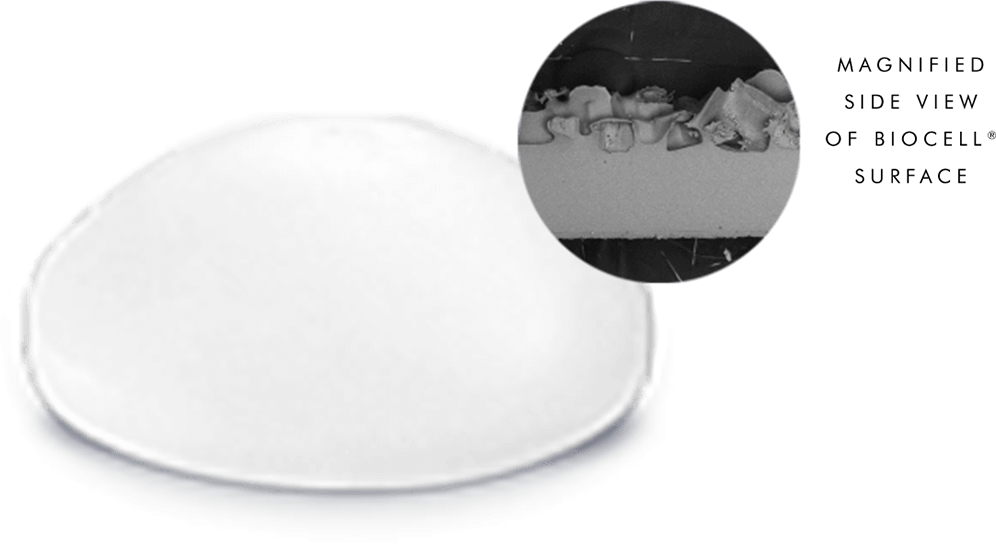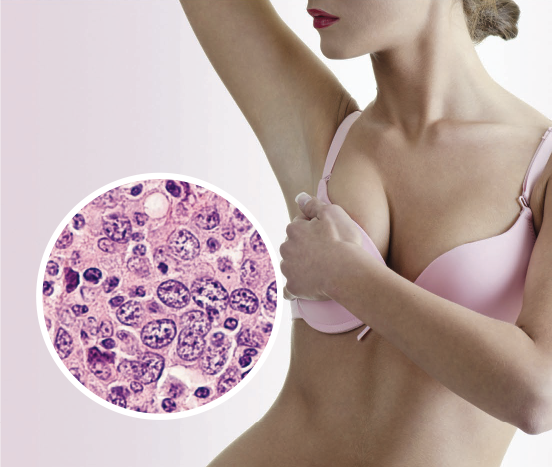Today, Allergan® voluntarily withdrew all BioCell® Textured Breast Implants and Tissue Expanders from the world markets due to an association with breast implant-associated anaplastic large cell lymphoma (BIA-ALCL).

Allergan® Biocell® textured breast implants have the highest association of BIA-ALCL.
Textured Breast Implants and BIA-ALCL
I have been posting about an association of BIA-ALCL and textured breast implants for some time here on the San Francisco Plastic Surgery Blog. While many types of textured breast implants exist, a higher association of BIA-ALCL has been found with more aggressively textured breast implants. Allegan® has the most aggressively textured breast implants and thus the highest association with BIA-ALCL.
BioCell® Textured Breast Implants and BIA-ALCL
BioCell® textured surface (shell) is a unique surface used only by Allergan®. A detailed list of the specific BioCell® textured devices marketed in the U.S. that are recalled can be found at the end of this post.
The FDA’s analysis was attributed to a new worldwide reported total of 573 unique BIA-ALCL cases including 33 patient deaths. Of the 573 cases of BIA-ALCL, 481 are reported to have Allergan® textured breast implants at the time of diagnosis. In addition, 12 of 13 deaths occurring in patients with BIA-ALCL where the manufacturer was known occurred in patients implanted with an Allergan® textured breast implant at the time of their BIA-ALCL diagnosis. The manufacturer and/or texture is unknown for the remaining 20 reported deaths from BIA-ALCL.
The risk of BIA-ALCL with Allergan® BioCell® textured implants is approximately 6 times the risk of BIA-ALCL with textured implants from other U.S. manufacturers.
BIA-ALCL Is Not Breast Cancer

Early treatment is the key to the cure for BIA-ALCL as it is for any medical illness. When in doubt; check it out.
BIA-ALCL is a type of non-Hodgkin’s lymphoma (cancer of the immune system). In most cases, BIA-ALCL is found in the scar tissue and fluid near the implant, but in some cases, it can spread throughout the body. At this time, the overall incidence of developing BIA-ALCL is considered to be low; however, a BIA-ALCL diagnosis is serious and can lead to death, especially if not diagnosed early or promptly treated. In most patients, BIA-ALCL is treated successfully with surgery to remove the implant and the scar tissue surrounding the implant; however, some patients may require treatment with chemotherapy and/or radiation therapy.
BIA-ALCL Is Rare
It is important to understand how rare the occurrence is and put the numbers into perspective. Literature indicates the current lifetime risk is about 1 in 20,000 patients with textured implants. BioCell® has a 7x to 8x greater incidence of BIA-ALCL compared to all other manufacturers’ textures, including Sientra® Texture and Mentor® Siltex. Geographic regions also reported variable risks including: Australia 1 in 3,345 for BioCell® and 1 in 86,029 for Siltex. In 2018, over 400,000 women underwent breast augmentation and reconstruction with implants in the U.S. Here are some comparative rates from the Sientra website:
- The average woman’s risk of developing breast cancer in her lifetime is 12.5%. This means that 1 out of 8 women may develop breast cancer in her lifetime.
- The risk of developing recurrent breast cancer after mastectomy is 5-8%. This means that 5 to 8 out of 100 women may develop recurrent breast cancer after mastectomy.
- The risk of capsular contracture through 10-years is ~14%. This means that 14 out of 100 patients may experience capsular contracture within 10 years after receiving implants.
- The risk of breast implant rupture through 10-years is ~8%. This means that 8 out of 100 patients may experience implant rupture within 10 years after receiving implants.
- The risk of developing BIA-ALCL from a textured breast implant is ~0.005%. This means that 1 out of 20,000 women with textured implants may develop BIA-ALCL.
FDA Is Not Recommending Removal Of Textured Implants

To date, the FDA has not recommended removal of textured breast implants, including those with Allergan®‘s BioCell® texturing.
From the FDA website:
- If you have no symptoms, we [the FDA] are not recommending the removal of these or other types of breast implants due to the low risk of developing BIA-ALCL.
- Know the symptoms of BIA-ALCL – primarily persistent swelling or pain near the breast implant – and monitor the area around your breast implants for any changes.
- Evaluation for BIA-ALCL typically involves a physical exam, imaging, and/or assessment of the fluid or tissue around the breast implant. It is important to undergo an evaluation to diagnose BIA-ALCL since a confirmed BIA-ALCL diagnosis may change the type of operation that should be performed.
- Based on discussions with your healthcare provider, patients with confirmed BIA-ALCL should undergo implant removal and removal of the surrounding scar capsule, which is a more extensive operation than implant removal alone.
- As with any implanted device, it is good to keep a record of the device manufacturer, unique device identifier, and implant model name. You may have received this information on a patient device card from your surgeon. If you would like to obtain any of this information, consider asking your surgeon or obtaining the record of your surgery (operative notes) from the facility where it was performed.
- Understand that most cases of BIA-ALCL occur many years after breast implant placement
- If you have any questions, talk to your healthcare provider.
- The FDA understands that today’s action may cause concern to patients who have breast implants, especially those who know they have one of the listed Allergan® BioCell® model implants or may not know the implant’s manufacturer or model. The FDA continues to monitor and evaluate reports of adverse events in databases, including external patient registries, and in scientific literature for the incidence of BIA-ALCL across all breast implants and other devices intended for use in the breast. The FDA further notes that the macro-textured implants, like the BioCell® textured implants manufactured by Allergan®, represent less than 5% of breast implants sold here in the U.S. In fact, textured implants account for only 10% of all breast implants sold in the U.S. To fully understand your risk of developing BIA-ALCL, the FDA recommends that patients and healthcare providers follow the FDA’s recommendations stated above. More information about BIA-ALCL can be found on the Breast Implants webpage. Additionally, the FDA will continue to update the public about developments in this area.
List of Affected BioCell® Products
Allergan® Natrelle Textured Saline-Filled Breast Implants (formerly McGhan RTV Saline-Filled Mammary Implant) approved under P990074. The following are the textured styles:
- Style 163 – BioCell® Textured Shaped Full Height, Full Projection Saline Breast Implants
- Style 168 – BioCell® Textured Round Moderate Profile Saline Breast Implants, also referred to as 168MP (168 Moderate Profile)
- Style 363 – BioCell® Textured Shaped Moderate Height, Full Projection Saline Breast Implants, Allergan® catalog includes 363LF, or 363 Low Height Full Projection
- Style 468 – BioCell® Textured Shaped Full Height Moderate Projection Saline Breast Implants
Allergan® Natrelle Silicone-Filled Textured Breast Implants (formerly Inamed Silicone-Filled Breast Implants) approved under P020056. All the new Natrelle Inspira BioCell® textured breast implant style numbers start with “T”. If your Allergan® Natrelle Inspira breast implant style starts with “S”, they are smooth, and are not part of this withdrawal. The following are the textured styles:
- Style 110 – BioCell® Textured Round Moderate Projection Gel Filled Breast Implants
- Style 115 – BioCell® Textured Round Midrange Projection Gel Filled Breast Implants
- Style 120 – BioCell® Textured Round High Projection Gel Filled Breast Implants
- Style TRL – Natrelle Inspira BioCell® Textured Responsive Silicone-Filled Breast Implants
- Style TRLP – Natrelle Inspira BioCell® Textured Responsive Silicone-Filled Breast Implants
- Style TRM – Natrelle Inspira BioCell® Textured Responsive Silicone-Filled Breast Implants
- Style TRF – Natrelle Inspira BioCell® Textured Responsive Silicone-Filled Breast Implants
- Style TRX – Natrelle Inspira BioCell® Textured Responsive Silicone-Filled Breast Implants
- Style TCL – Natrelle Inspira BioCell® Textured Cohesive Silicone-Filled Breast Implants
- Style TCLP – Natrelle Inspira BioCell® Textured Cohesive Silicone-Filled Breast Implants
- Style TCM – Natrelle Inspira BioCell® Textured Cohesive Silicone-Filled Breast Implants
- Style TCF – Natrelle Inspira BioCell® Textured Cohesive Silicone-Filled Breast Implants
- Style TCX – Natrelle Inspira BioCell® Textured Cohesive Silicone-Filled Breast Implants
- Style TSL – Natrelle BioCell® Textured Soft Touch Silicone-Filled Breast Implants
- Style TSLP – Natrelle BioCell® Textured Soft Touch Silicone-Filled Breast Implants
- Style TSM – Natrelle BioCell® Textured Soft Touch Silicone-Filled Breast Implants
- Style TSF – Natrelle BioCell® Textured Soft Touch Silicone-Filled Breast Implants
- Style TSX – Natrelle BioCell® Textured Soft Touch Silicone-Filled Breast Implants
Natrelle 410 Highly Cohesive Anatomically Shaped Silicone Filled Breast Implants approved under P040046. All style 410 implants are BioCell® textured. The following are the textured styles:
- Style 410FM
- Style 410FF
- Style 410MM
- Style 410 MF
- Style 410 FL
- Style 410 ML
- Style 410 LL
- Style 410 LM
- Style 410 LF
- Style 410 FX
- Style 410 MX
- Style 410 LX
Allergan® tissue expanders for the breast that have BIOCELL texturing originally cleared as:
- Natrelle 133 Plus Tissue Expander (K143354)
- Natrelle 133 Tissue Expander with Suture Tabs (K102806)
What To Do?
If you don’t know what breast implants you have, find out. All my patients are given a card with their implant information to keep in a safe place. If your surgeon did not give you this information, or you can’t find it there are options. You can
- call you surgeon’s office
- contact the surgery center or hospital where you had surgery
- contact the breast implant manufacturer
90% of the breast implants used in the U.S. are smooth and are not affected by this action. In my office, we have always preferred the results obtained with smooth breast implants. Less than 1% of the implants I have placed are textured, and not all of them are Allergan®. In fact, in my over 20 years of practice, I have removed more textured breast implants than I have placed. If you had your breast augmentation with me, and are wondering which implants you have, your breast implant card should state whether your implants are smooth or textures. If you don’t have your card, just give us a call and we will look it up.
If you have Allergan® BioCell® textured breast implants, don’t panic. Your risk of developing BIA-ALCL is still very low. If you are asymptomatic, the current recommendation is to leave them alone, and monitor for changes. If you have changes, do not delay in getting evaluated by your doctor. The most common presentation is an increase in size of one breast years after breast augmentation, usually due to a collection of fluid around the breast implant (seroma). While, most seromas are not due to BIA-ALCL, all should be investigated. If you have any concerns, contact your plastic surgeon for more detailed information.
Previous Post Next Post